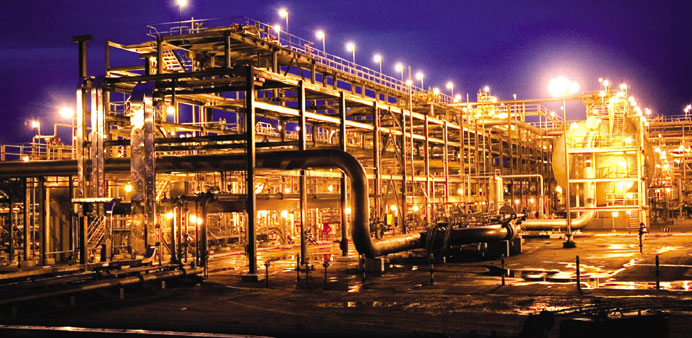A Saudi Aramco oil refinery. Saudi Arabia trimmed oil output in October due to reduced use of crude in domestic power plants and refineries, sources said yesterday.
Reuters/London
Opec oil output has fallen in October from the previous month, a Reuters survey found yesterday, as declines in top producers Saudi Arabia and Iraq outweighed higher supply from African members.
The drops are not indicative of deliberate supply cuts to prop up prices, sources in the survey said, and the Organisation of the Petroleum Exporting Countries is still pumping close to a record high as major producers focus on defending market share.
Opec supply has fallen in October to 31.64mn barrels per day (bpd) from a revised 31.76mn in September, according to the survey, based on shipping data and information from sources at oil companies, Opec and consultants. With one day left in October, the final figures could be
revised.
Even so, Opec has boosted production by almost 1.5mn bpd since the November 2014 switch to defending market share. Despite the decline this month, output is not far below July’s 31.88mn bpd, the highest since Reuters records began in 1997.
The Opec increase has added to ample supplies, which have helped cut prices by more than half from June 2014 to below $50 a barrel. Still, with reductions in capital spending by oil companies expected to curb future supply, analysts see signs that Opec’s strategy will deliver.
“Clearly, Opec’s long-game strategy is working,” said Harry Tchilinguirian, global head of commodity strategy at BNP Paribas. “In the end, Opec’s strategy is creating the conditions for higher prices for longer in a couple of years’ time.”
The biggest supply drop in October has come from Saudi Arabia, which trimmed output due to reduced use of crude in domestic power plants and refineries, sources in the survey said, despite higher exports.
“Supply to the market is down,” said a source who tracks Saudi output. “Exports are up but this has been more than offset by lower refinery runs due to maintenance and lower direct burn.”
Direct burn – the use of crude in Saudi power plants – usually drops in cooler months due to reduced air-conditioning needs. Maintenance was being carried out at the Saudi Yasref refinery, reducing crude consumption.
Saudi output, at 10.10mn bpd, remains not far below the record high of 10.56mn bpd it pumped in June.
Exports from Iraq’s main outlet, its southern terminals, were higher for much of October – reaching a record 3.1mn bpd in the first 27 days of the month – but have slowed since as poor weather delayed cargoes, shipping data showed.
Shipments from Iraq’s north by the Kurdistan Regional Government via Ceyhan in Turkey have edged lower, while those by Iraq’s State Oil Marketing Organisation have fallen to zero from about 20,000 bpd in September, the survey found.
Smaller increases have come from Opec’s two west African producers, Nigeria and Angola, and from Libya. Angola and Nigeria exported more crude this month, but a force majeure on shipments of Nigeria’s Forcados limited the increase from that country. Libyan output rose slightly, the survey found, but remains a fraction of the pre-conflict rate.
Output in Iran, Opec’s second-largest producer until sanctions forced a cut in exports in 2012, continues to edge up, the survey found. A lifting of sanctions on Iran has the potential to boost Opec output further in 2016.



